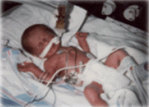PT 861 - The High Risk Infant
Principle #1: Promote neurobehavioural organization
- Neurobehavioural organization refers to an infant's ability to effectively manage both internal and environmental stresses while maintaining physiological homeostasis. This neurobehavioural organization emerges from the interaction between the developing CNS and the environment, and provides the basis upon which an infant can begin to interact with his or her environment and development proceed.
- Much of this neurobehavioural organization develops during the final trimester of pregnancy. Essential elements of this organization include:
- flexor tone to provide early anti-gravity support
- organization of primary reflexes
- practice of breathing, sucking and swallowing movements
- adequate development and autoregulation of cardio-pulmonary function
- These essential elements are either absent or poorly organized in pre-term infants. Leter, Tonick and Brazelton (1982) developed a model to explain the four subsystems around which behaviour is organized:
- Autonomic: the organization of respiration, heart rate, thermoregulation and digestion.
- Motor: the organization of posture, tone and activity of the trunk, extremities and face.
- State: the organization of the range of states available to the infant, including the transitions from one state to another, as well as the clearness and differentiation of states.
- Attention/interactive: the organization of alertness, including the ability to maintain an alert state, and take in and to respond appropriately to environmental and internal input: social, cognitive and emotional inputs are examples.
- These subsystems are organized in hierarchical fashion, meaning that stability at the first level is required before the infant can begin to organize behaviour at the next level up. As an example, an infant that is struggling to achieve cardiopulmonary homeostasis will have difficulty assuming or maintaining an alert state and interacting with his or her environment. Similarly, active movements can contribute to instability in the autonomic organization and, therefore, an infant unable to maintain physiological homeostasis may remain fairly immobile.
